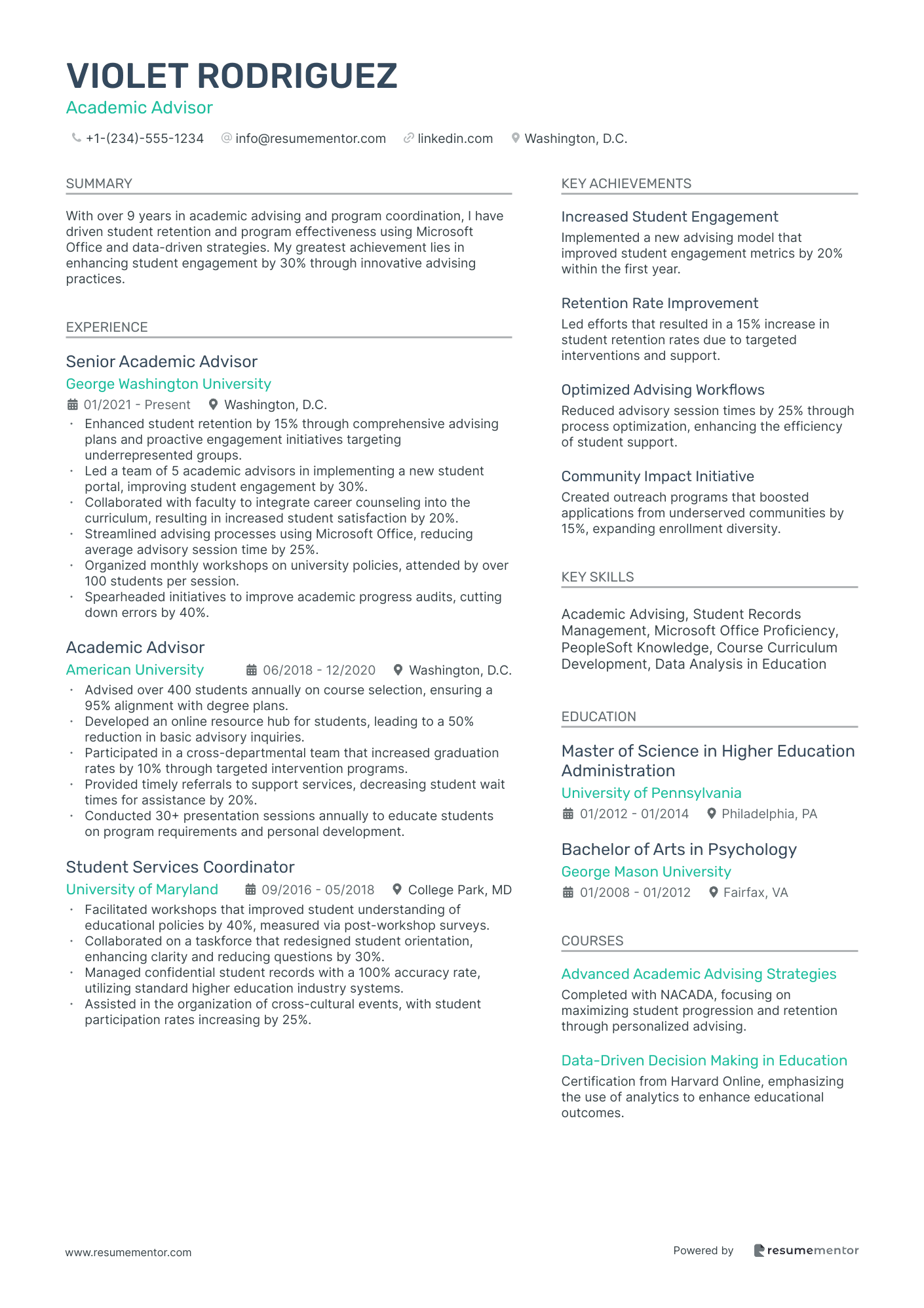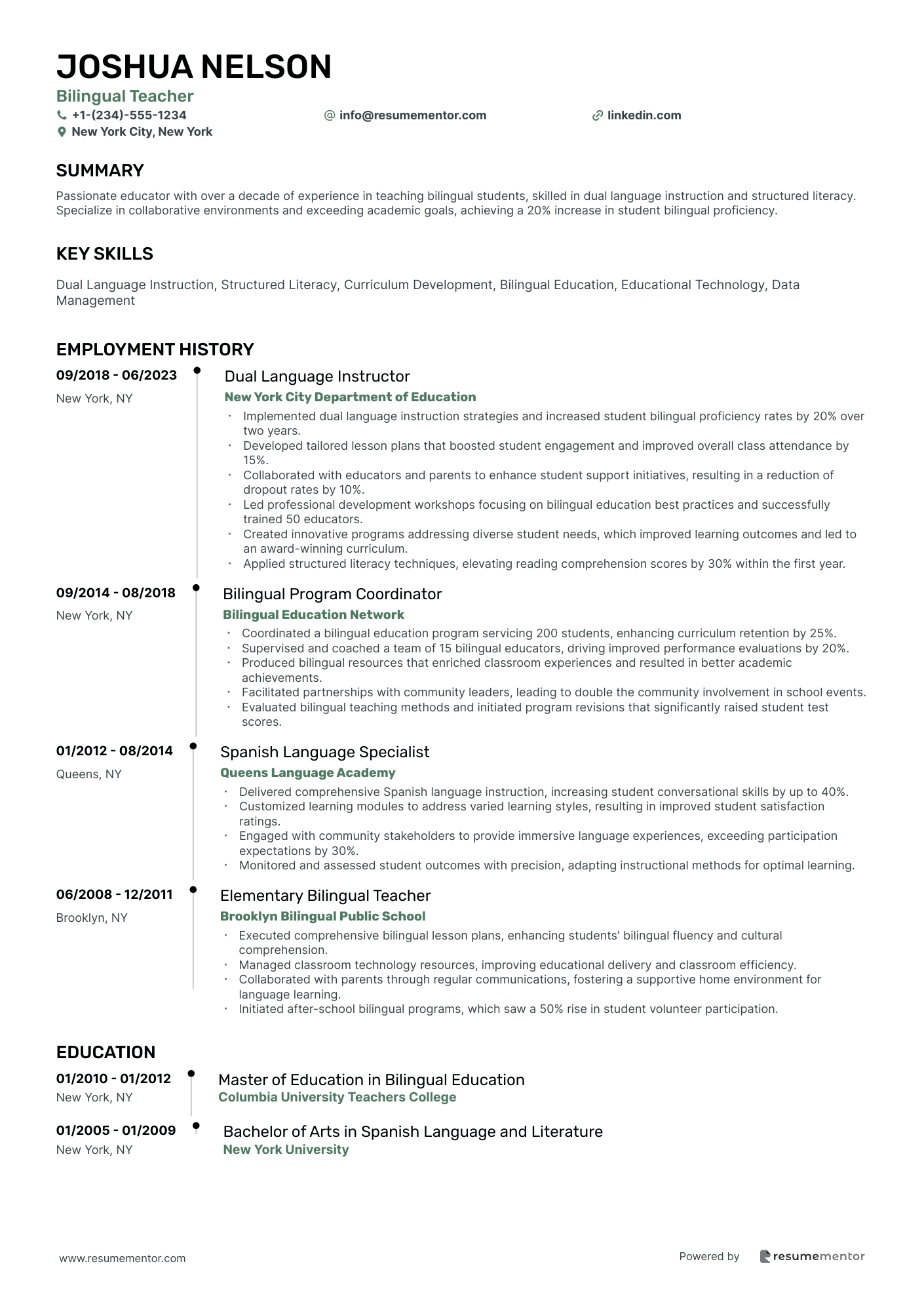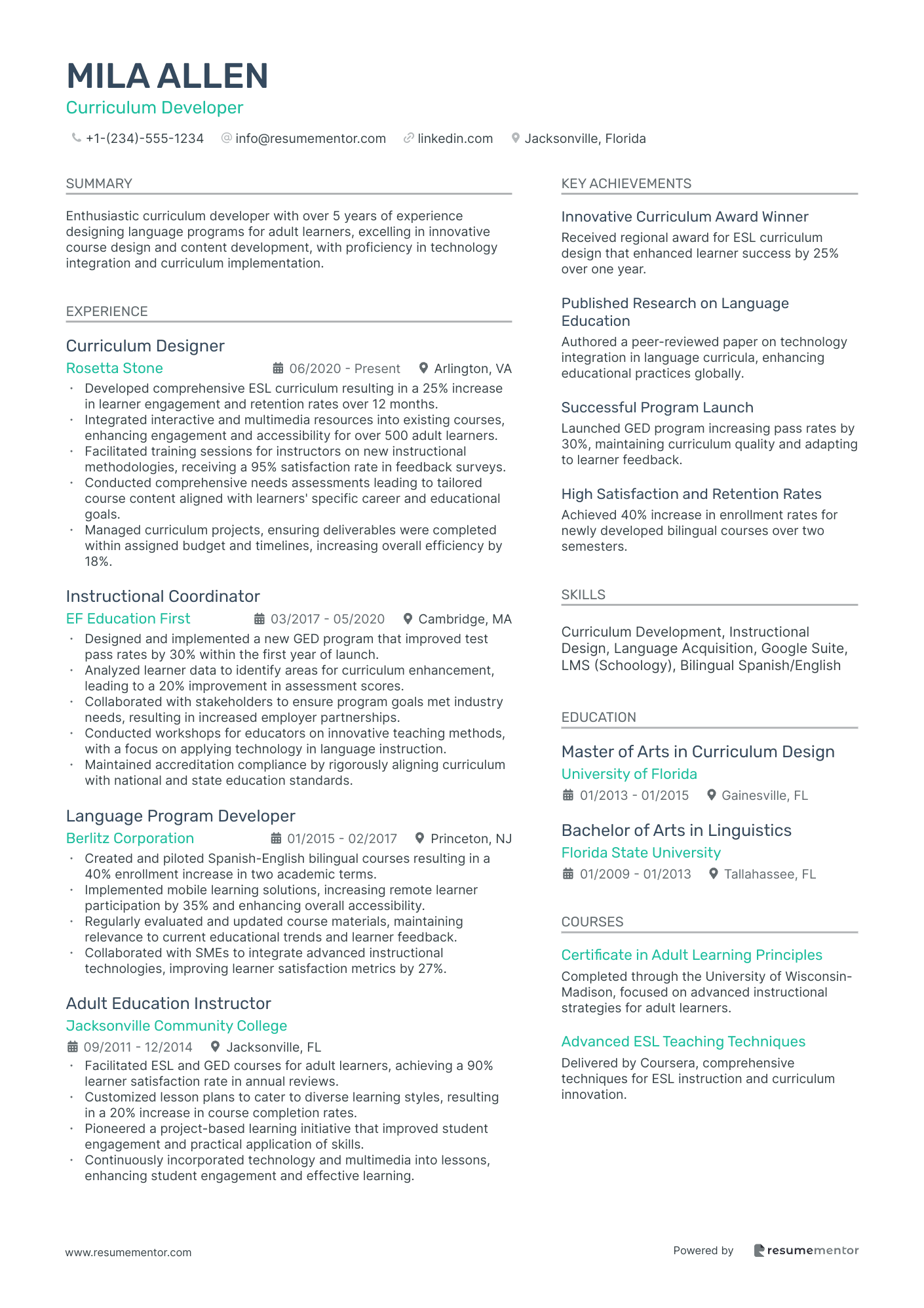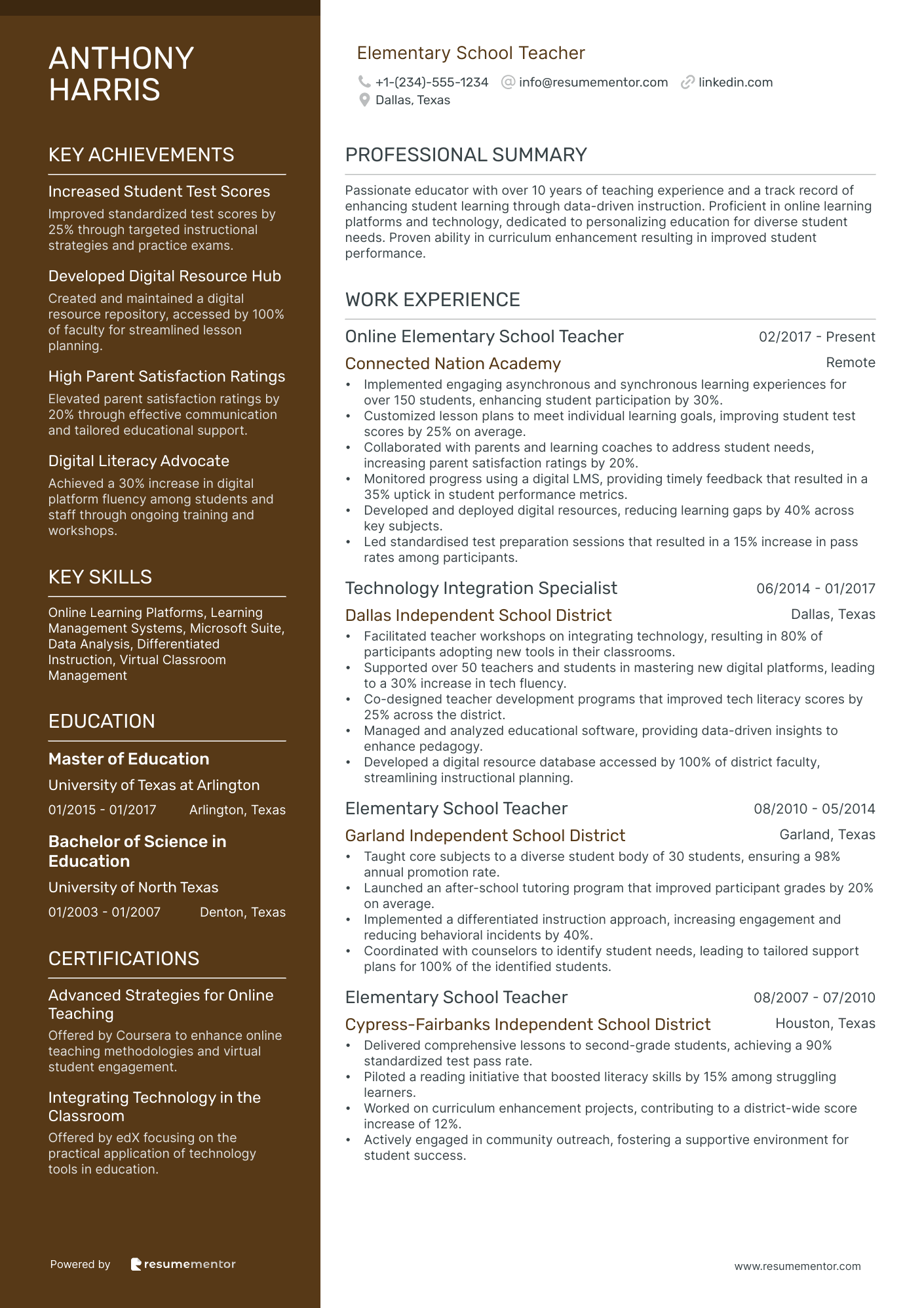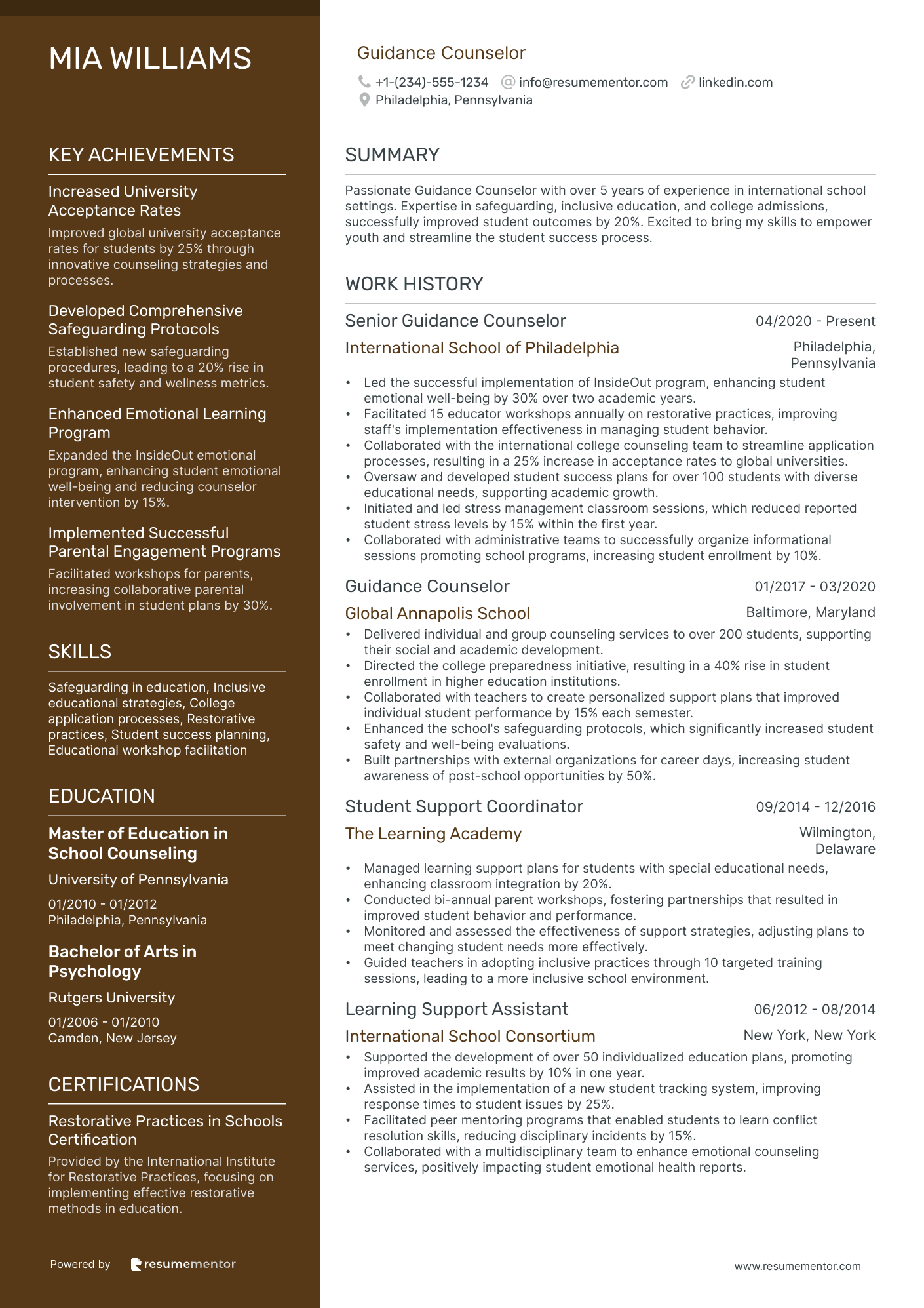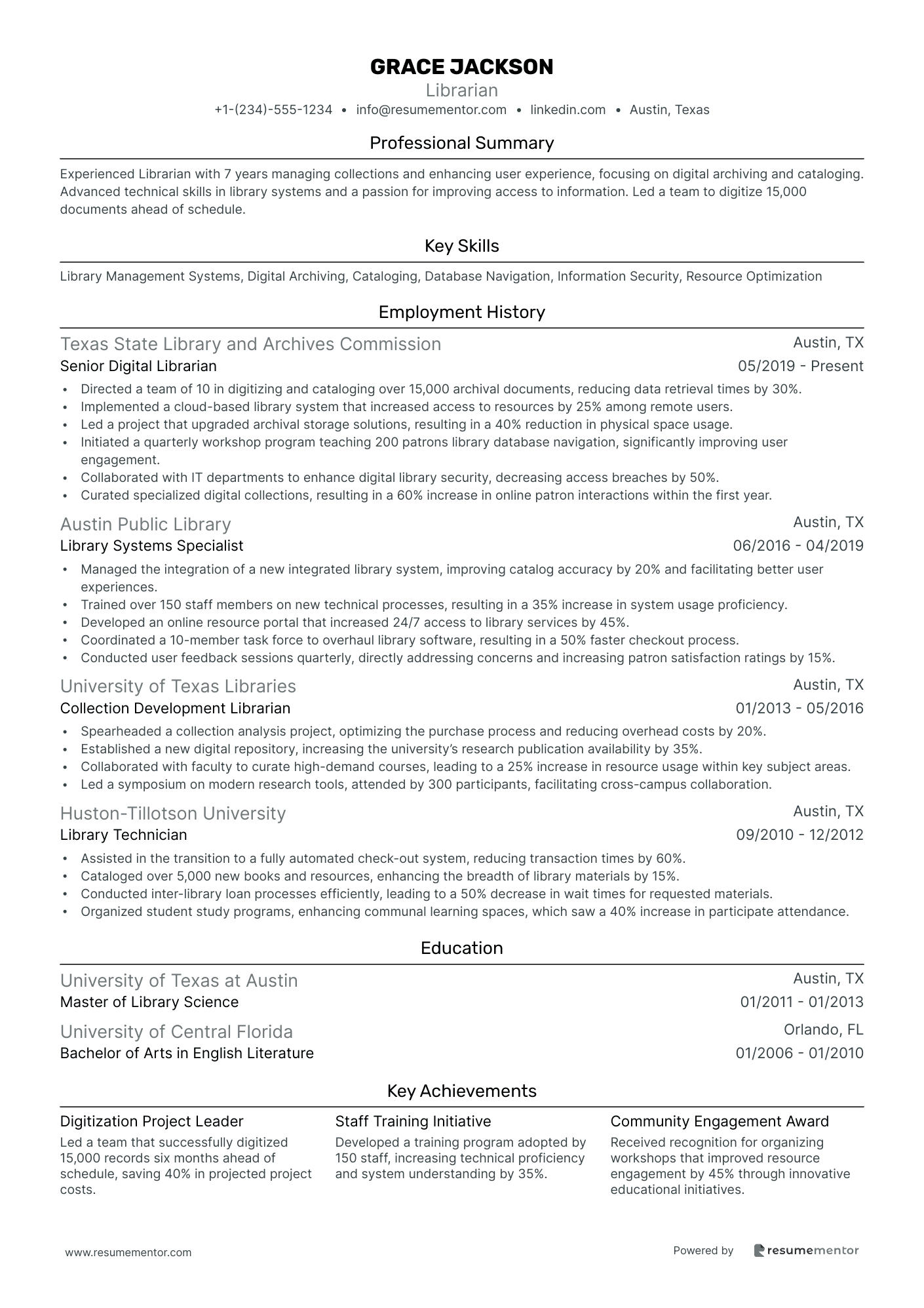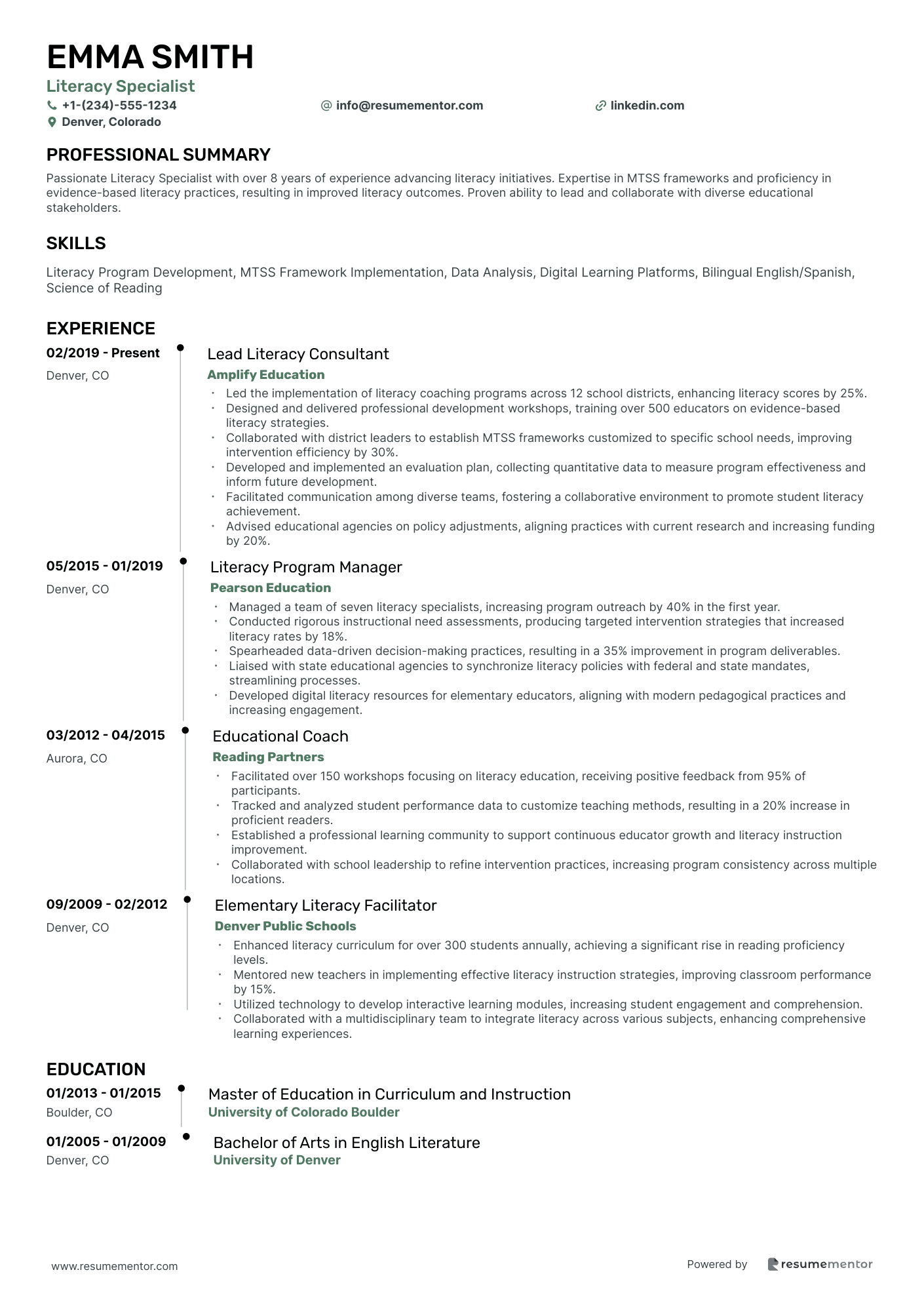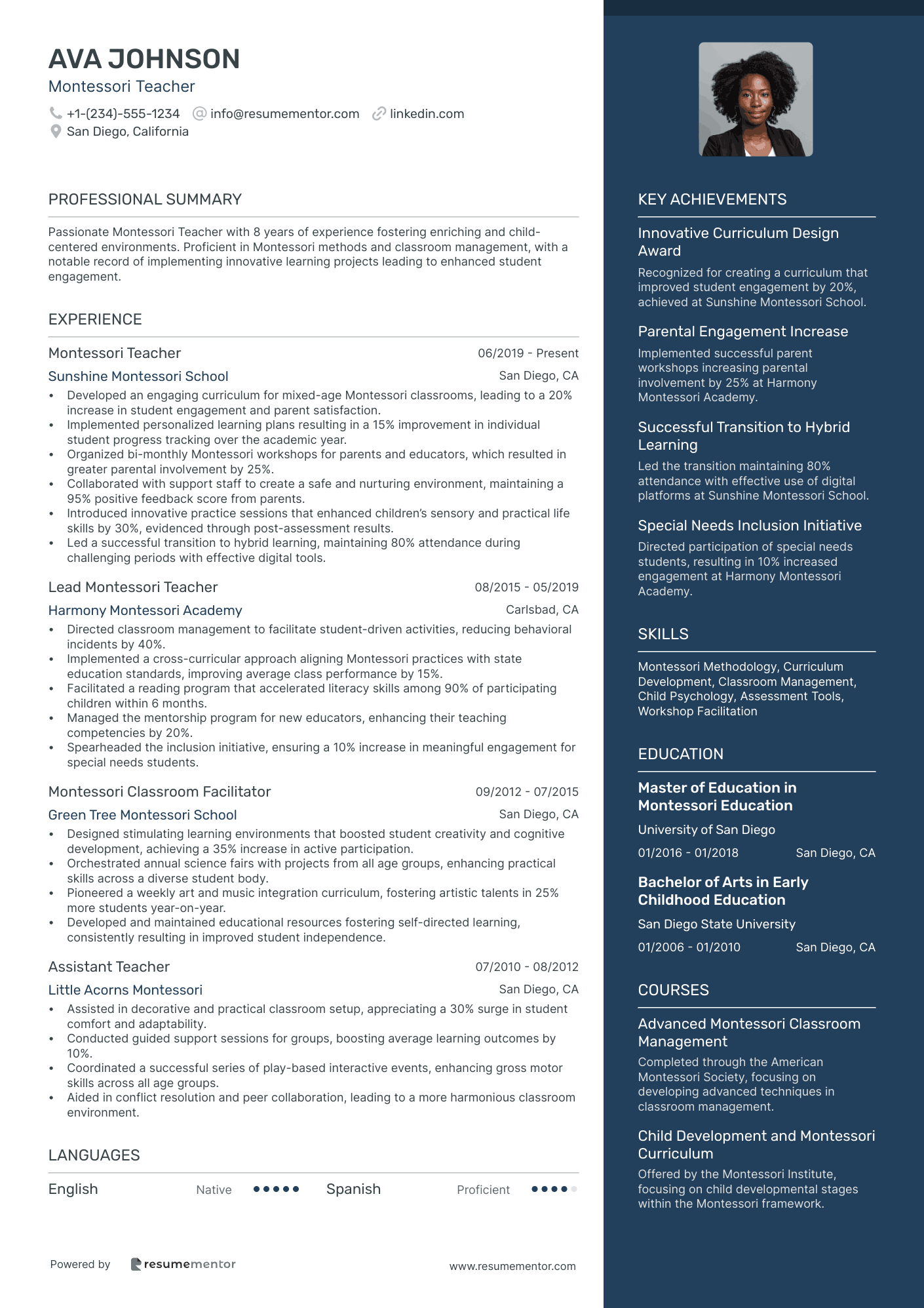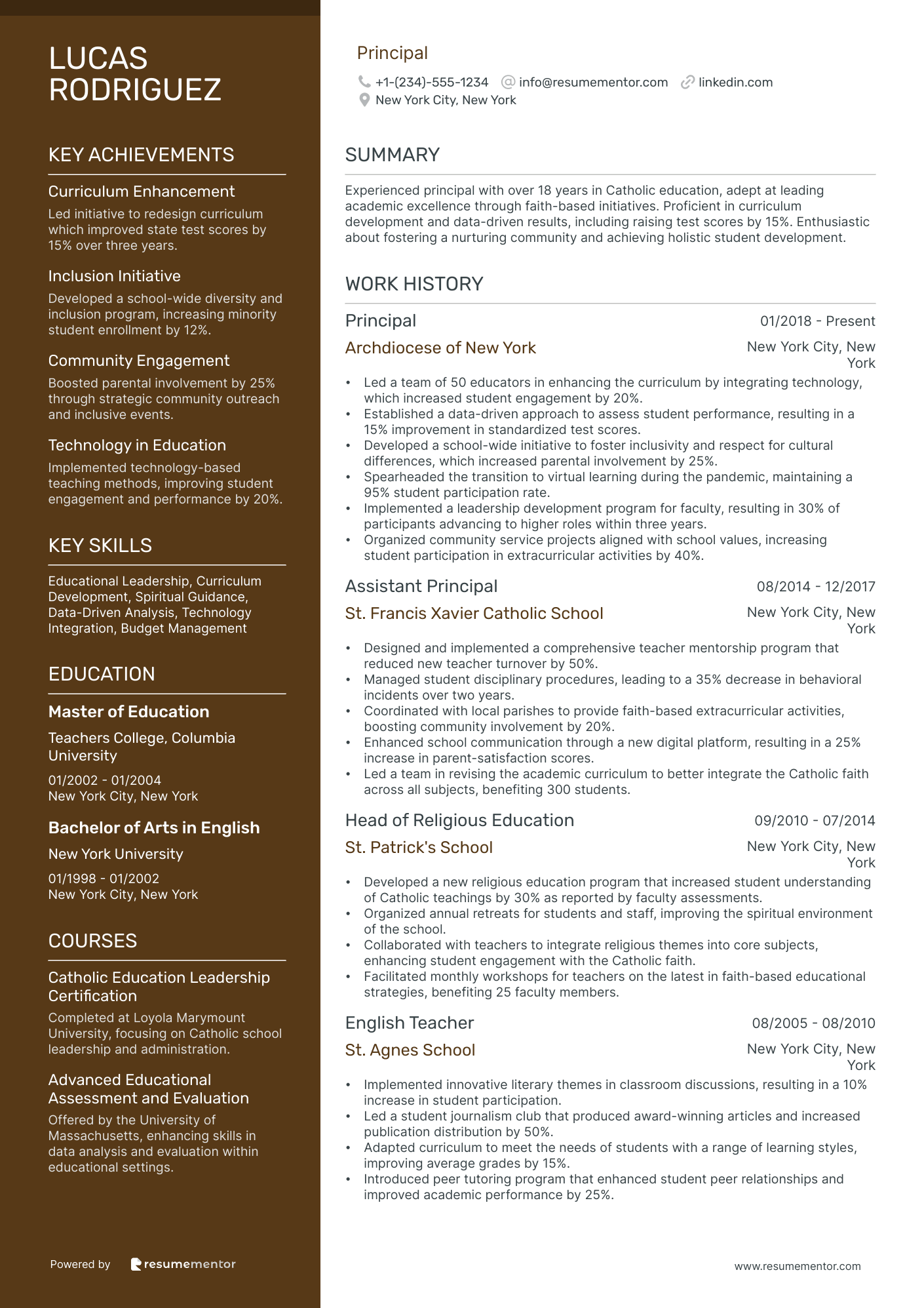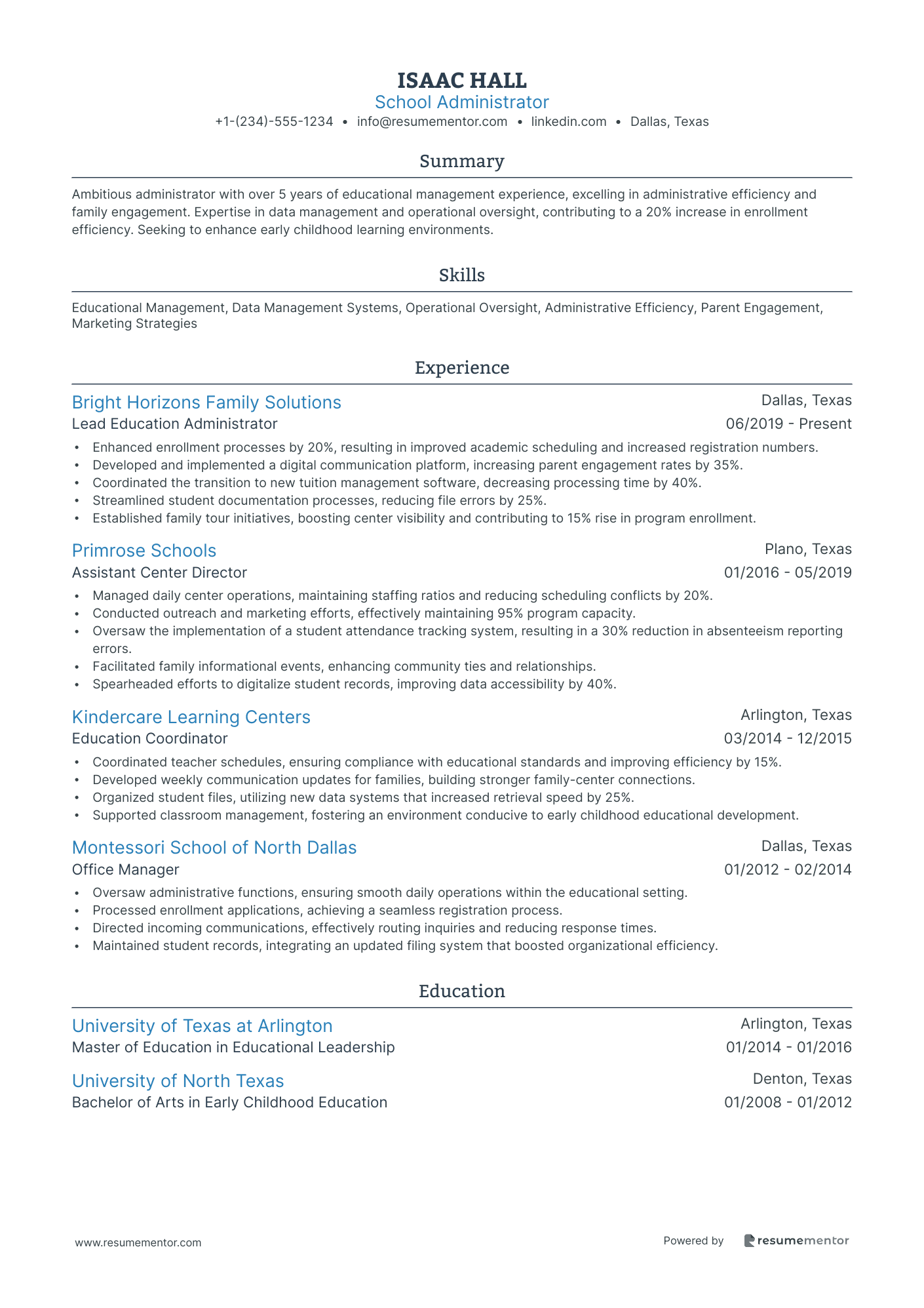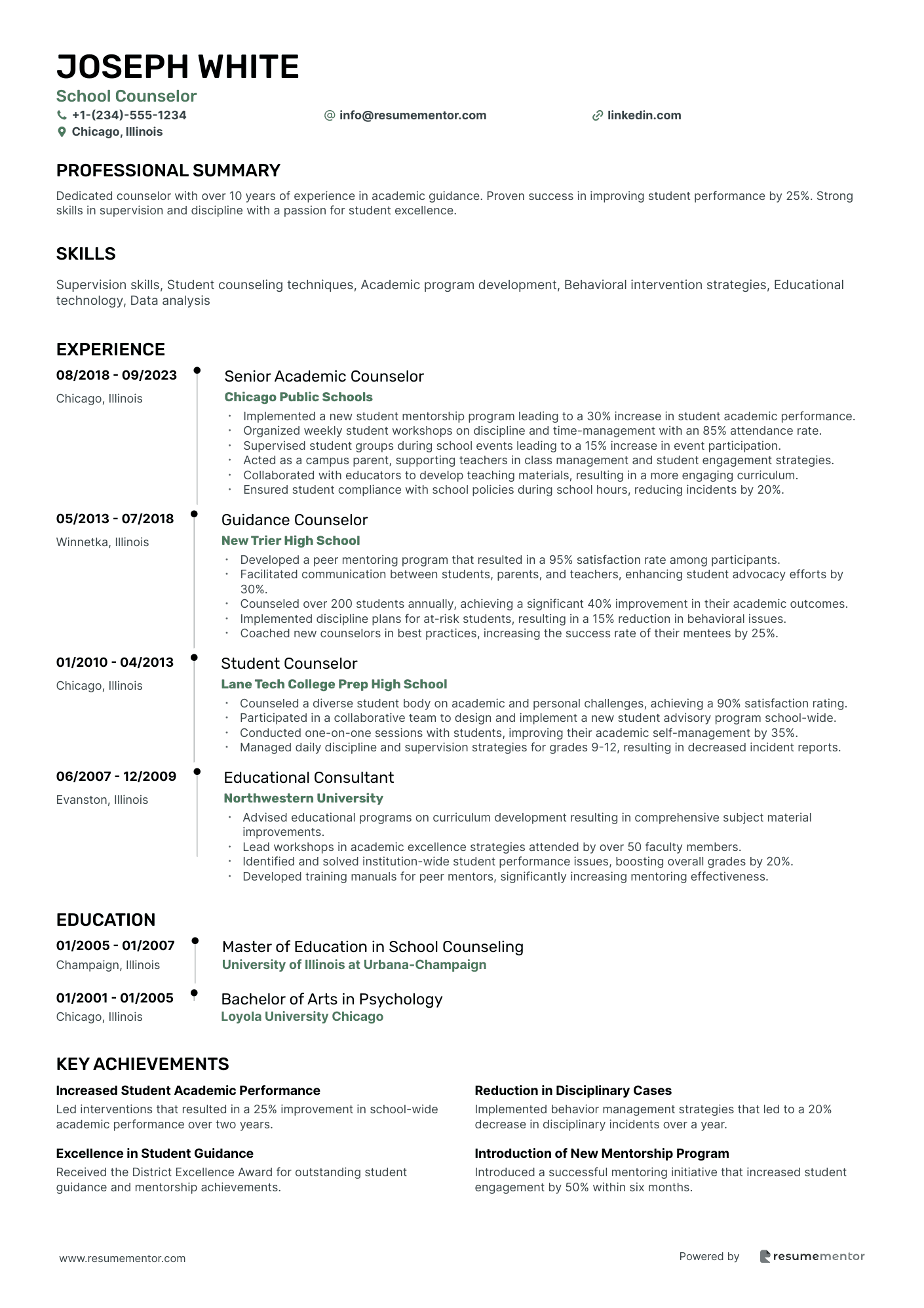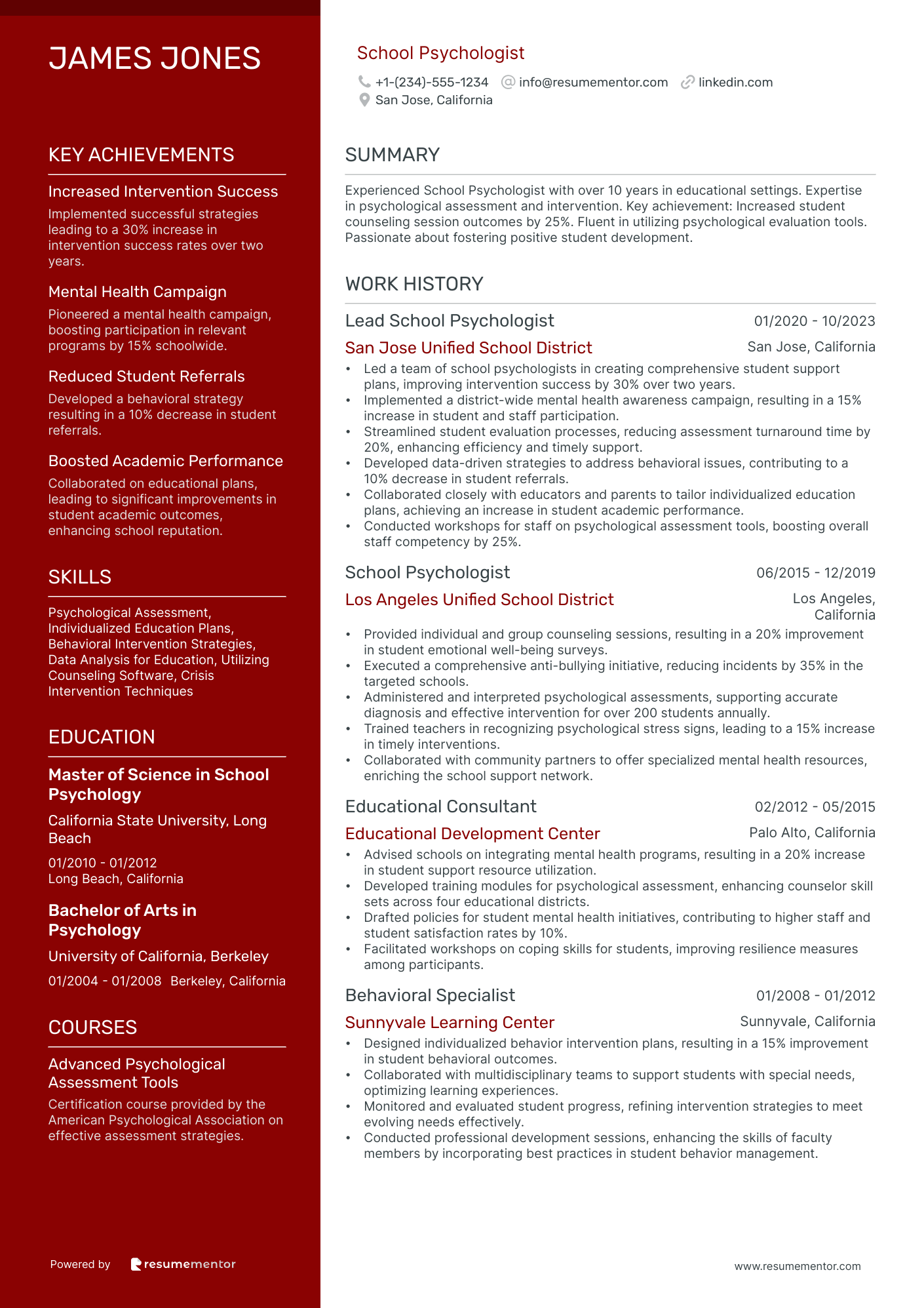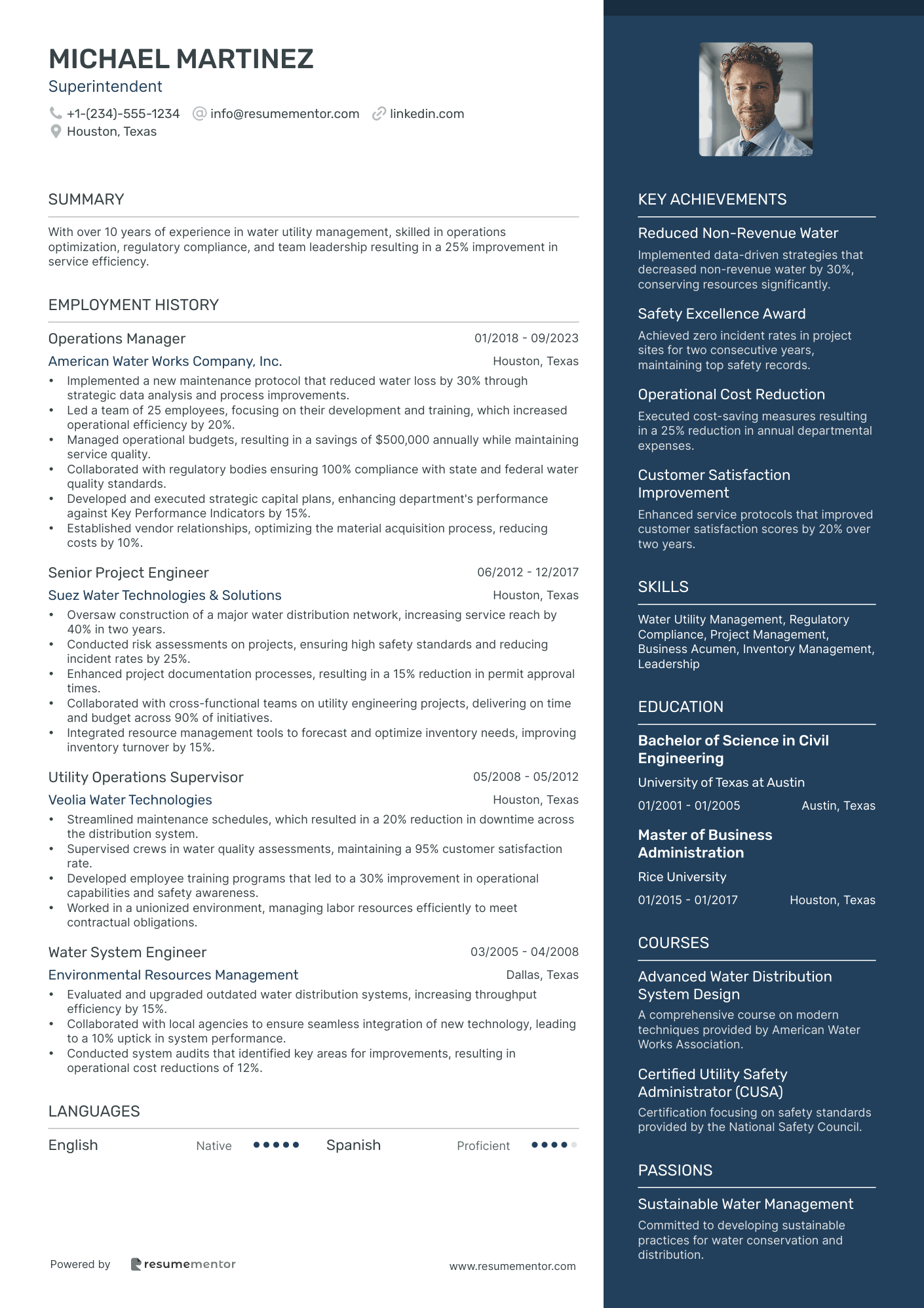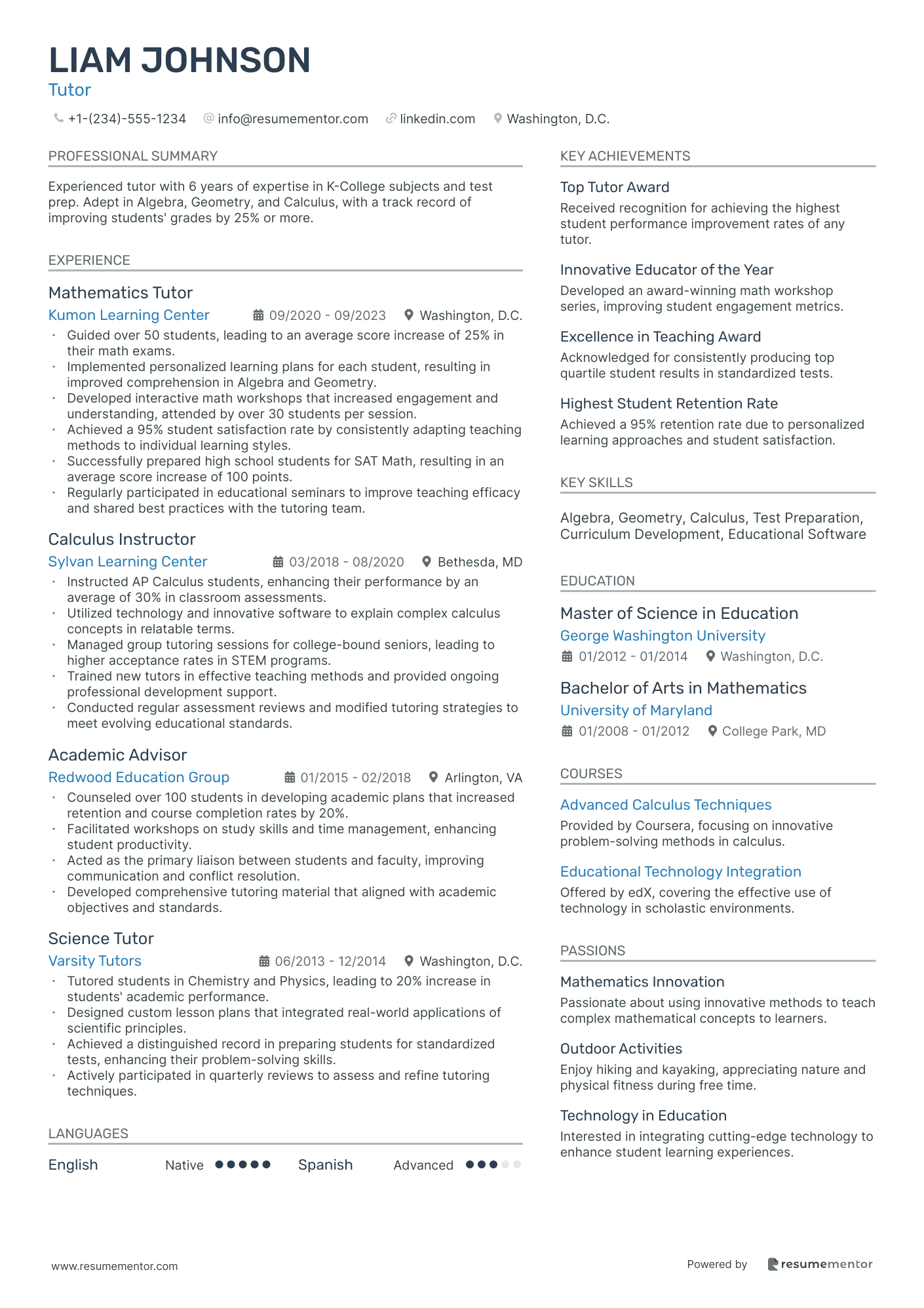Education Resume Examples
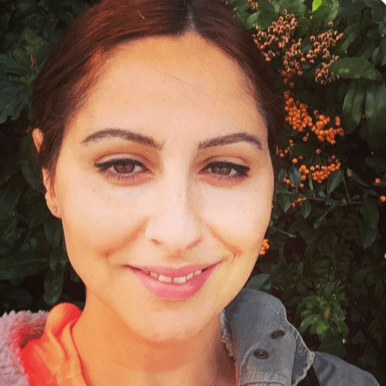
Mar 13, 2025
|
12 min read
Craft your perfect education resume and school the competition with tips on highlighting your teaching credentials, experience, and passion for learning, ensuring you stand out in the classroom job market like a star student.
Rated by 348 people

Academic Advisor resume sample
- •Enhanced student retention by 15% through comprehensive advising plans and proactive engagement initiatives targeting underrepresented groups.
- •Led a team of 5 academic advisors in implementing a new student portal, improving student engagement by 30%.
- •Collaborated with faculty to integrate career counseling into the curriculum, resulting in increased student satisfaction by 20%.
- •Streamlined advising processes using Microsoft Office, reducing average advisory session time by 25%.
- •Organized monthly workshops on university policies, attended by over 100 students per session.
- •Spearheaded initiatives to improve academic progress audits, cutting down errors by 40%.
- •Advised over 400 students annually on course selection, ensuring a 95% alignment with degree plans.
- •Developed an online resource hub for students, leading to a 50% reduction in basic advisory inquiries.
- •Participated in a cross-departmental team that increased graduation rates by 10% through targeted intervention programs.
- •Provided timely referrals to support services, decreasing student wait times for assistance by 20%.
- •Conducted 30+ presentation sessions annually to educate students on program requirements and personal development.
- •Facilitated workshops that improved student understanding of educational policies by 40%, measured via post-workshop surveys.
- •Collaborated on a taskforce that redesigned student orientation, enhancing clarity and reducing questions by 30%.
- •Managed confidential student records with a 100% accuracy rate, utilizing standard higher education industry systems.
- •Assisted in the organization of cross-cultural events, with student participation rates increasing by 25%.
- •Supported the development of academic advisement materials, increasing awareness of degree options by 20%.
- •Performed academic progress audits for over 200 students per semester, optimizing student course trajectory.
- •Implemented office filing system improvements, enhancing information retrieval speed by 40%.
- •Assisted in the development of community outreach programs, resulting in a 15% increase in applications from underserved communities.
Bilingual Teacher resume sample
- •Implemented dual language instruction strategies and increased student bilingual proficiency rates by 20% over two years.
- •Developed tailored lesson plans that boosted student engagement and improved overall class attendance by 15%.
- •Collaborated with educators and parents to enhance student support initiatives, resulting in a reduction of dropout rates by 10%.
- •Led professional development workshops focusing on bilingual education best practices and successfully trained 50 educators.
- •Created innovative programs addressing diverse student needs, which improved learning outcomes and led to an award-winning curriculum.
- •Applied structured literacy techniques, elevating reading comprehension scores by 30% within the first year.
- •Coordinated a bilingual education program servicing 200 students, enhancing curriculum retention by 25%.
- •Supervised and coached a team of 15 bilingual educators, driving improved performance evaluations by 20%.
- •Produced bilingual resources that enriched classroom experiences and resulted in better academic achievements.
- •Facilitated partnerships with community leaders, leading to double the community involvement in school events.
- •Evaluated bilingual teaching methods and initiated program revisions that significantly raised student test scores.
- •Delivered comprehensive Spanish language instruction, increasing student conversational skills by up to 40%.
- •Customized learning modules to address varied learning styles, resulting in improved student satisfaction ratings.
- •Engaged with community stakeholders to provide immersive language experiences, exceeding participation expectations by 30%.
- •Monitored and assessed student outcomes with precision, adapting instructional methods for optimal learning.
- •Executed comprehensive bilingual lesson plans, enhancing students' bilingual fluency and cultural comprehension.
- •Managed classroom technology resources, improving educational delivery and classroom efficiency.
- •Collaborated with parents through regular communications, fostering a supportive home environment for language learning.
- •Initiated after-school bilingual programs, which saw a 50% rise in student volunteer participation.
College Professor resume sample
- •Implemented interactive digital learning tools, increasing student engagement and test scores by 25% on average.
- •Updated and refined syllabi to align with curriculum standards and learning objectives, impacting over 200 students.
- •Deposited revised examination protocols, reducing grading time by 30%, which allowed a quicker feedback cycle for students.
- •Held consistent office hours both in-person and remotely, resulting in a 40% increase in student support and satisfaction.
- •Conducted workshops on effective online teaching strategies, attended by over 50 faculty members, thereby boosting collective teaching skills.
- •Pioneered a mentorship program for high-potential students, with 80% of participants advancing to higher-level courses.
- •Developed a collaborative learning framework, resulting in a 35% improvement in student teamwork assignments.
- •Redesigned core math courses, improving student success rates by 20% through better resources and minimal technological barriers.
- •Executed data-driven approaches to optimize curriculum, benefiting 90% of students with tailored learning paths.
- •Provided one-on-one tutoring sessions that improved struggling students' final grades by at least one letter grade.
- •Served on the academic integrity committee to ensure high grading standards and consistency across departments.
- •Introduced adaptive online assessments, enhancing students' learning outcomes and achieving a pass rate increase by 15%.
- •Facilitated student engagement with virtual office hours, which saw a 50% attendance boost compared to previous years.
- •Streamlined course materials, which cut down preparation time by 25% without sacrificing student understanding.
- •Led peer review sessions that resulted in the development of innovative teaching methodologies, influencing future course designs.
- •Managed large lecture classes of over 100 students, maintaining a 90% satisfaction rate as reflected in end-of-term evaluations.
- •Edited and improved math learning resources, achieving a 10% increase in average class performance.
- •Facilitated math competitions that significantly heightened student interest and participation in extracurricular activities.
- •Utilized technology effectively in lesson plans, resulting in a seamless transition to digital learning platforms.
Curriculum Developer resume sample
- •Developed comprehensive ESL curriculum resulting in a 25% increase in learner engagement and retention rates over 12 months.
- •Integrated interactive and multimedia resources into existing courses, enhancing engagement and accessibility for over 500 adult learners.
- •Facilitated training sessions for instructors on new instructional methodologies, receiving a 95% satisfaction rate in feedback surveys.
- •Conducted comprehensive needs assessments leading to tailored course content aligned with learners' specific career and educational goals.
- •Managed curriculum projects, ensuring deliverables were completed within assigned budget and timelines, increasing overall efficiency by 18%.
- •Designed and implemented a new GED program that improved test pass rates by 30% within the first year of launch.
- •Analyzed learner data to identify areas for curriculum enhancement, leading to a 20% improvement in assessment scores.
- •Collaborated with stakeholders to ensure program goals met industry needs, resulting in increased employer partnerships.
- •Conducted workshops for educators on innovative teaching methods, with a focus on applying technology in language instruction.
- •Maintained accreditation compliance by rigorously aligning curriculum with national and state education standards.
- •Created and piloted Spanish-English bilingual courses resulting in a 40% enrollment increase in two academic terms.
- •Implemented mobile learning solutions, increasing remote learner participation by 35% and enhancing overall accessibility.
- •Regularly evaluated and updated course materials, maintaining relevance to current educational trends and learner feedback.
- •Collaborated with SMEs to integrate advanced instructional technologies, improving learner satisfaction metrics by 27%.
- •Facilitated ESL and GED courses for adult learners, achieving a 90% learner satisfaction rate in annual reviews.
- •Customized lesson plans to cater to diverse learning styles, resulting in a 20% increase in course completion rates.
- •Pioneered a project-based learning initiative that improved student engagement and practical application of skills.
- •Continuously incorporated technology and multimedia into lessons, enhancing student engagement and effective learning.
Educational Consultant resume sample
- •Guided over 45 students annually through college admissions, leading to an overall admission rate increase of 30%.
- •Conducted thorough curriculum assessments, resulting in improved academic planning for each student's unique profile.
- •Developed and implemented comprehensive extracurricular strategies, enhancing student profiles in 95% of cases.
- •Led quarterly workshops on college essay writing, resulting in over 85% student workshops receiving recognition for excellence.
- •Coached students in independent projects, leading to the successful launch of 20 non-profit initiatives.
- •Maintained consistent communication with students and families, achieving a satisfaction rate of 98% in feedback surveys.
- •Managed relationships with 40+ families, resulting in a 90% client retention rate over two years.
- •Conducted 60 seminars on standardized test strategies, improving student test scores by an average of 25%.
- •Collaborated with a team to facilitate over 50 college discovery sessions, receiving a 4.8/5 satisfaction rating.
- •Oversaw essay brainstorming sessions, editing over 200 college essays, resulting in compelling applicant narratives.
- •Organized marketing presentations that informed over 500 prospective clients, expanding educational outreach.
- •Advised high school juniors and seniors, achieving a 100% client referral rate.
- •Designed personalized academic plans, leading to a 15% improvement in student GPA scores.
- •Spearheaded a mentoring program, resulting in increased student engagement in extracurriculars by 20%.
- •Provided tailored college preparation services, with a 95% application success rate for senior students.
- •Evaluated over 2,000 student applications yearly, contributing to a refined admissions process.
- •Led marketing outreach efforts that increased the application pool by 12% within the first year.
- •Collaborated on the development of new admissions guidelines, enhancing the decision-making workflow.
- •Organized workshops on the admissions process, improving student preparedness by 30%.
Elementary School Teacher resume sample
- •Implemented engaging asynchronous and synchronous learning experiences for over 150 students, enhancing student participation by 30%.
- •Customized lesson plans to meet individual learning goals, improving student test scores by 25% on average.
- •Collaborated with parents and learning coaches to address student needs, increasing parent satisfaction ratings by 20%.
- •Monitored progress using a digital LMS, providing timely feedback that resulted in a 35% uptick in student performance metrics.
- •Developed and deployed digital resources, reducing learning gaps by 40% across key subjects.
- •Led standardised test preparation sessions that resulted in a 15% increase in pass rates among participants.
- •Facilitated teacher workshops on integrating technology, resulting in 80% of participants adopting new tools in their classrooms.
- •Supported over 50 teachers and students in mastering new digital platforms, leading to a 30% increase in tech fluency.
- •Co-designed teacher development programs that improved tech literacy scores by 25% across the district.
- •Managed and analyzed educational software, providing data-driven insights to enhance pedagogy.
- •Developed a digital resource database accessed by 100% of district faculty, streamlining instructional planning.
- •Taught core subjects to a diverse student body of 30 students, ensuring a 98% annual promotion rate.
- •Launched an after-school tutoring program that improved participant grades by 20% on average.
- •Implemented a differentiated instruction approach, increasing engagement and reducing behavioral incidents by 40%.
- •Coordinated with counselors to identify student needs, leading to tailored support plans for 100% of the identified students.
- •Delivered comprehensive lessons to second-grade students, achieving a 90% standardized test pass rate.
- •Piloted a reading initiative that boosted literacy skills by 15% among struggling learners.
- •Worked on curriculum enhancement projects, contributing to a district-wide score increase of 12%.
- •Actively engaged in community outreach, fostering a supportive environment for student success.
Guidance Counselor resume sample
- •Led the successful implementation of InsideOut program, enhancing student emotional well-being by 30% over two academic years.
- •Facilitated 15 educator workshops annually on restorative practices, improving staff's implementation effectiveness in managing student behavior.
- •Collaborated with the international college counseling team to streamline application processes, resulting in a 25% increase in acceptance rates to global universities.
- •Oversaw and developed student success plans for over 100 students with diverse educational needs, supporting academic growth.
- •Initiated and led stress management classroom sessions, which reduced reported student stress levels by 15% within the first year.
- •Collaborated with administrative teams to successfully organize informational sessions promoting school programs, increasing student enrollment by 10%.
- •Delivered individual and group counseling services to over 200 students, supporting their social and academic development.
- •Directed the college preparedness initiative, resulting in a 40% rise in student enrollment in higher education institutions.
- •Collaborated with teachers to create personalized support plans that improved individual student performance by 15% each semester.
- •Enhanced the school's safeguarding protocols, which significantly increased student safety and well-being evaluations.
- •Built partnerships with external organizations for career days, increasing student awareness of post-school opportunities by 50%.
- •Managed learning support plans for students with special educational needs, enhancing classroom integration by 20%.
- •Conducted bi-annual parent workshops, fostering partnerships that resulted in improved student behavior and performance.
- •Monitored and assessed the effectiveness of support strategies, adjusting plans to meet changing student needs more effectively.
- •Guided teachers in adopting inclusive practices through 10 targeted training sessions, leading to a more inclusive school environment.
- •Supported the development of over 50 individualized education plans, promoting improved academic results by 10% in one year.
- •Assisted in the implementation of a new student tracking system, improving response times to student issues by 25%.
- •Facilitated peer mentoring programs that enabled students to learn conflict resolution skills, reducing disciplinary incidents by 15%.
- •Collaborated with a multidisciplinary team to enhance emotional counseling services, positively impacting student emotional health reports.
Instructional Coordinator resume sample
- •Led the creation and execution of the district's digital content strategy, managing a budget of $2M, thereby enhancing resource accessibility for over 120 schools.
- •Collaborated with 15 school-based instructional designers to implement innovative teaching techniques across multiple schools, resulting in a 25% improvement in student engagement.
- •Overhauled the division's Learning Management System, training 200+ staff members, and integrating new functionalities to streamline user experience.
- •Managed the Google Administrator Console, optimizing user roles and permissions, increasing operational efficiency by 30%.
- •Prepared and coordinated RFPs for technology procurements, securing $500K in funding for instructional content acquisitions.
- •Supervised the Central Library Services office, leading a team to improve acquisition speed, reducing turnaround time by 20%.
- •Facilitated the integration of new instructional technologies district-wide, boosting teacher proficiency by 35% through targeted training programs.
- •Spearheaded a division-wide initiative to enhance digital content management, resulting in a 50% reduction in access times for educational resources.
- •Coordinated with curriculum development teams to align new technologies with instructional goals, leading to a 20% increase in test scores.
- •Maintained and updated procedural documentation, improving process transparency and facilitating better communication across departments.
- •Led the deployment of cloud-based applications across 100+ sites, ensuring secure and efficient user access and data management.
- •Conducted professional development sessions for 500+ teachers, increasing classroom integration of instructional technologies by 40%.
- •Evaluated and selected digital tools for classroom use, streamlining the technology adoption process and enhancing educational quality.
- •Supported school leaders in technology planning, resulting in strategic improvements in infrastructure boosting reliability by 30%.
- •Drove a project to revamp instructional content delivery, resulting in enhanced accessibility and engagement for over 30,000 students.
- •Managed a 100k digital content budget, optimizing procurement processes and reducing costs by 10% through strategic vendor negotiations.
- •Collaborated with IT staff to upgrade network infrastructure, improving system uptime from 85% to 95%.
- •Implemented a district-wide staff training program, enhancing user knowledge and reducing support tickets by 20%.
- •Developed tools for instructional application management, improving user interface and operational workflow throughout the district.
Librarian resume sample
- •Directed a team of 10 in digitizing and cataloging over 15,000 archival documents, reducing data retrieval times by 30%.
- •Implemented a cloud-based library system that increased access to resources by 25% among remote users.
- •Led a project that upgraded archival storage solutions, resulting in a 40% reduction in physical space usage.
- •Initiated a quarterly workshop program teaching 200 patrons library database navigation, significantly improving user engagement.
- •Collaborated with IT departments to enhance digital library security, decreasing access breaches by 50%.
- •Curated specialized digital collections, resulting in a 60% increase in online patron interactions within the first year.
- •Managed the integration of a new integrated library system, improving catalog accuracy by 20% and facilitating better user experiences.
- •Trained over 150 staff members on new technical processes, resulting in a 35% increase in system usage proficiency.
- •Developed an online resource portal that increased 24/7 access to library services by 45%.
- •Coordinated a 10-member task force to overhaul library software, resulting in a 50% faster checkout process.
- •Conducted user feedback sessions quarterly, directly addressing concerns and increasing patron satisfaction ratings by 15%.
- •Spearheaded a collection analysis project, optimizing the purchase process and reducing overhead costs by 20%.
- •Established a new digital repository, increasing the university’s research publication availability by 35%.
- •Collaborated with faculty to curate high-demand courses, leading to a 25% increase in resource usage within key subject areas.
- •Led a symposium on modern research tools, attended by 300 participants, facilitating cross-campus collaboration.
- •Assisted in the transition to a fully automated check-out system, reducing transaction times by 60%.
- •Cataloged over 5,000 new books and resources, enhancing the breadth of library materials by 15%.
- •Conducted inter-library loan processes efficiently, leading to a 50% decrease in wait times for requested materials.
- •Organized student study programs, enhancing communal learning spaces, which saw a 40% increase in participate attendance.
Literacy Specialist resume sample
- •Led the implementation of literacy coaching programs across 12 school districts, enhancing literacy scores by 25%.
- •Designed and delivered professional development workshops, training over 500 educators on evidence-based literacy strategies.
- •Collaborated with district leaders to establish MTSS frameworks customized to specific school needs, improving intervention efficiency by 30%.
- •Developed and implemented an evaluation plan, collecting quantitative data to measure program effectiveness and inform future development.
- •Facilitated communication among diverse teams, fostering a collaborative environment to promote student literacy achievement.
- •Advised educational agencies on policy adjustments, aligning practices with current research and increasing funding by 20%.
- •Managed a team of seven literacy specialists, increasing program outreach by 40% in the first year.
- •Conducted rigorous instructional need assessments, producing targeted intervention strategies that increased literacy rates by 18%.
- •Spearheaded data-driven decision-making practices, resulting in a 35% improvement in program deliverables.
- •Liaised with state educational agencies to synchronize literacy policies with federal and state mandates, streamlining processes.
- •Developed digital literacy resources for elementary educators, aligning with modern pedagogical practices and increasing engagement.
- •Facilitated over 150 workshops focusing on literacy education, receiving positive feedback from 95% of participants.
- •Tracked and analyzed student performance data to customize teaching methods, resulting in a 20% increase in proficient readers.
- •Established a professional learning community to support continuous educator growth and literacy instruction improvement.
- •Collaborated with school leadership to refine intervention practices, increasing program consistency across multiple locations.
- •Enhanced literacy curriculum for over 300 students annually, achieving a significant rise in reading proficiency levels.
- •Mentored new teachers in implementing effective literacy instruction strategies, improving classroom performance by 15%.
- •Utilized technology to develop interactive learning modules, increasing student engagement and comprehension.
- •Collaborated with a multidisciplinary team to integrate literacy across various subjects, enhancing comprehensive learning experiences.
Montessori Teacher resume sample
- •Developed an engaging curriculum for mixed-age Montessori classrooms, leading to a 20% increase in student engagement and parent satisfaction.
- •Implemented personalized learning plans resulting in a 15% improvement in individual student progress tracking over the academic year.
- •Organized bi-monthly Montessori workshops for parents and educators, which resulted in greater parental involvement by 25%.
- •Collaborated with support staff to create a safe and nurturing environment, maintaining a 95% positive feedback score from parents.
- •Introduced innovative practice sessions that enhanced children’s sensory and practical life skills by 30%, evidenced through post-assessment results.
- •Led a successful transition to hybrid learning, maintaining 80% attendance during challenging periods with effective digital tools.
- •Directed classroom management to facilitate student-driven activities, reducing behavioral incidents by 40%.
- •Implemented a cross-curricular approach aligning Montessori practices with state education standards, improving average class performance by 15%.
- •Facilitated a reading program that accelerated literacy skills among 90% of participating children within 6 months.
- •Managed the mentorship program for new educators, enhancing their teaching competencies by 20%.
- •Spearheaded the inclusion initiative, ensuring a 10% increase in meaningful engagement for special needs students.
- •Designed stimulating learning environments that boosted student creativity and cognitive development, achieving a 35% increase in active participation.
- •Orchestrated annual science fairs with projects from all age groups, enhancing practical skills across a diverse student body.
- •Pioneered a weekly art and music integration curriculum, fostering artistic talents in 25% more students year-on-year.
- •Developed and maintained educational resources fostering self-directed learning, consistently resulting in improved student independence.
- •Assisted in decorative and practical classroom setup, appreciating a 30% surge in student comfort and adaptability.
- •Conducted guided support sessions for groups, boosting average learning outcomes by 10%.
- •Coordinated a successful series of play-based interactive events, enhancing gross motor skills across all age groups.
- •Aided in conflict resolution and peer collaboration, leading to a more harmonious classroom environment.
Online Course Instructor resume sample
- •Facilitated virtual AI workshops, boosting student engagement by 35% with interactive and project-based learning approaches.
- •Developed and delivered 15 unique lesson plans on machine learning, resulting in 90% student satisfaction.
- •Employed AI tools to enhance team collaboration, leading to a 20% increase in project efficiency.
- •Trained 5 fellow instructors in utilizing Zoom for optimal virtual classroom experiences.
- •Monitored and evaluated student performance, helping 85% improve their understanding of complex AI concepts.
- •Coordinated with curriculum developers to align lessons with educational goals, ensuring relevance and accuracy.
- •Managed education programs, resulting in a 25% increase in participant retention over two years.
- •Oversaw curriculum development for AI-related courses, enhancing course quality by 30%.
- •Executed online workshops across multiple platforms, achieving a 95% satisfaction rate among attendees.
- •Implemented feedback mechanisms, driving a 50% improvement in course delivery and content quality.
- •Led a team of 10 educators, fostering an innovative teaching environment and boosting staff morale by 40%.
- •Conducted technical training sessions on emerging technologies, reaching over 500 students internationally.
- •Redesigned training modules for enhanced user engagement, resulting in a 20% increase in course completion rates.
- •Collaborated with subject matter experts to deliver accurate and up-to-date course content.
- •Monitored industry trends to update the curriculum, leading to a 15% growth in course enrollments.
- •Enhanced the online learning experience through the development of innovative digital content.
- •Implemented new learning strategies, improving student engagement by 30% over a one-year tenure.
- •Facilitated workshops for 200+ participants, focusing on AI and data analytics.
- •Analyzed course data to identify areas for improvement, leading to a 10% increase in overall course ratings.
Principal resume sample
- •Led a team of 50 educators in enhancing the curriculum by integrating technology, which increased student engagement by 20%.
- •Established a data-driven approach to assess student performance, resulting in a 15% improvement in standardized test scores.
- •Developed a school-wide initiative to foster inclusivity and respect for cultural differences, which increased parental involvement by 25%.
- •Spearheaded the transition to virtual learning during the pandemic, maintaining a 95% student participation rate.
- •Implemented a leadership development program for faculty, resulting in 30% of participants advancing to higher roles within three years.
- •Organized community service projects aligned with school values, increasing student participation in extracurricular activities by 40%.
- •Designed and implemented a comprehensive teacher mentorship program that reduced new teacher turnover by 50%.
- •Managed student disciplinary procedures, leading to a 35% decrease in behavioral incidents over two years.
- •Coordinated with local parishes to provide faith-based extracurricular activities, boosting community involvement by 20%.
- •Enhanced school communication through a new digital platform, resulting in a 25% increase in parent-satisfaction scores.
- •Led a team in revising the academic curriculum to better integrate the Catholic faith across all subjects, benefiting 300 students.
- •Developed a new religious education program that increased student understanding of Catholic teachings by 30% as reported by faculty assessments.
- •Organized annual retreats for students and staff, improving the spiritual environment of the school.
- •Collaborated with teachers to integrate religious themes into core subjects, enhancing student engagement with the Catholic faith.
- •Facilitated monthly workshops for teachers on the latest in faith-based educational strategies, benefiting 25 faculty members.
- •Implemented innovative literary themes in classroom discussions, resulting in a 10% increase in student participation.
- •Led a student journalism club that produced award-winning articles and increased publication distribution by 50%.
- •Adapted curriculum to meet the needs of students with a range of learning styles, improving average grades by 15%.
- •Introduced peer tutoring program that enhanced student peer relationships and improved academic performance by 25%.
School Administrator resume sample
- •Enhanced enrollment processes by 20%, resulting in improved academic scheduling and increased registration numbers.
- •Developed and implemented a digital communication platform, increasing parent engagement rates by 35%.
- •Coordinated the transition to new tuition management software, decreasing processing time by 40%.
- •Streamlined student documentation processes, reducing file errors by 25%.
- •Established family tour initiatives, boosting center visibility and contributing to 15% rise in program enrollment.
- •Managed daily center operations, maintaining staffing ratios and reducing scheduling conflicts by 20%.
- •Conducted outreach and marketing efforts, effectively maintaining 95% program capacity.
- •Oversaw the implementation of a student attendance tracking system, resulting in a 30% reduction in absenteeism reporting errors.
- •Facilitated family informational events, enhancing community ties and relationships.
- •Spearheaded efforts to digitalize student records, improving data accessibility by 40%.
- •Coordinated teacher schedules, ensuring compliance with educational standards and improving efficiency by 15%.
- •Developed weekly communication updates for families, building stronger family-center connections.
- •Organized student files, utilizing new data systems that increased retrieval speed by 25%.
- •Supported classroom management, fostering an environment conducive to early childhood educational development.
- •Oversaw administrative functions, ensuring smooth daily operations within the educational setting.
- •Processed enrollment applications, achieving a seamless registration process.
- •Directed incoming communications, effectively routing inquiries and reducing response times.
- •Maintained student records, integrating an updated filing system that boosted organizational efficiency.
School Counselor resume sample
- •Implemented a new student mentorship program leading to a 30% increase in student academic performance.
- •Organized weekly student workshops on discipline and time-management with an 85% attendance rate.
- •Supervised student groups during school events leading to a 15% increase in event participation.
- •Acted as a campus parent, supporting teachers in class management and student engagement strategies.
- •Collaborated with educators to develop teaching materials, resulting in a more engaging curriculum.
- •Ensured student compliance with school policies during school hours, reducing incidents by 20%.
- •Developed a peer mentoring program that resulted in a 95% satisfaction rate among participants.
- •Facilitated communication between students, parents, and teachers, enhancing student advocacy efforts by 30%.
- •Counseled over 200 students annually, achieving a significant 40% improvement in their academic outcomes.
- •Implemented discipline plans for at-risk students, resulting in a 15% reduction in behavioral issues.
- •Coached new counselors in best practices, increasing the success rate of their mentees by 25%.
- •Counseled a diverse student body on academic and personal challenges, achieving a 90% satisfaction rating.
- •Participated in a collaborative team to design and implement a new student advisory program school-wide.
- •Conducted one-on-one sessions with students, improving their academic self-management by 35%.
- •Managed daily discipline and supervision strategies for grades 9-12, resulting in decreased incident reports.
- •Advised educational programs on curriculum development resulting in comprehensive subject material improvements.
- •Lead workshops in academic excellence strategies attended by over 50 faculty members.
- •Identified and solved institution-wide student performance issues, boosting overall grades by 20%.
- •Developed training manuals for peer mentors, significantly increasing mentoring effectiveness.
School Psychologist resume sample
- •Led a team of school psychologists in creating comprehensive student support plans, improving intervention success by 30% over two years.
- •Implemented a district-wide mental health awareness campaign, resulting in a 15% increase in student and staff participation.
- •Streamlined student evaluation processes, reducing assessment turnaround time by 20%, enhancing efficiency and timely support.
- •Developed data-driven strategies to address behavioral issues, contributing to a 10% decrease in student referrals.
- •Collaborated closely with educators and parents to tailor individualized education plans, achieving an increase in student academic performance.
- •Conducted workshops for staff on psychological assessment tools, boosting overall staff competency by 25%.
- •Provided individual and group counseling sessions, resulting in a 20% improvement in student emotional well-being surveys.
- •Executed a comprehensive anti-bullying initiative, reducing incidents by 35% in the targeted schools.
- •Administered and interpreted psychological assessments, supporting accurate diagnosis and effective intervention for over 200 students annually.
- •Trained teachers in recognizing psychological stress signs, leading to a 15% increase in timely interventions.
- •Collaborated with community partners to offer specialized mental health resources, enriching the school support network.
- •Advised schools on integrating mental health programs, resulting in a 20% increase in student support resource utilization.
- •Developed training modules for psychological assessment, enhancing counselor skill sets across four educational districts.
- •Drafted policies for student mental health initiatives, contributing to higher staff and student satisfaction rates by 10%.
- •Facilitated workshops on coping skills for students, improving resilience measures among participants.
- •Designed individualized behavior intervention plans, resulting in a 15% improvement in student behavioral outcomes.
- •Collaborated with multidisciplinary teams to support students with special needs, optimizing learning experiences.
- •Monitored and evaluated student progress, refining intervention strategies to meet evolving needs effectively.
- •Conducted professional development sessions, enhancing the skills of faculty members by incorporating best practices in student behavior management.
Superintendent resume sample
- •Implemented a new maintenance protocol that reduced water loss by 30% through strategic data analysis and process improvements.
- •Led a team of 25 employees, focusing on their development and training, which increased operational efficiency by 20%.
- •Managed operational budgets, resulting in a savings of $500,000 annually while maintaining service quality.
- •Collaborated with regulatory bodies ensuring 100% compliance with state and federal water quality standards.
- •Developed and executed strategic capital plans, enhancing department's performance against Key Performance Indicators by 15%.
- •Established vendor relationships, optimizing the material acquisition process, reducing costs by 10%.
- •Oversaw construction of a major water distribution network, increasing service reach by 40% in two years.
- •Conducted risk assessments on projects, ensuring high safety standards and reducing incident rates by 25%.
- •Enhanced project documentation processes, resulting in a 15% reduction in permit approval times.
- •Collaborated with cross-functional teams on utility engineering projects, delivering on time and budget across 90% of initiatives.
- •Integrated resource management tools to forecast and optimize inventory needs, improving inventory turnover by 15%.
- •Streamlined maintenance schedules, which resulted in a 20% reduction in downtime across the distribution system.
- •Supervised crews in water quality assessments, maintaining a 95% customer satisfaction rate.
- •Developed employee training programs that led to a 30% improvement in operational capabilities and safety awareness.
- •Worked in a unionized environment, managing labor resources efficiently to meet contractual obligations.
- •Evaluated and upgraded outdated water distribution systems, increasing throughput efficiency by 15%.
- •Collaborated with local agencies to ensure seamless integration of new technology, leading to a 10% uptick in system performance.
- •Conducted system audits that identified key areas for improvements, resulting in operational cost reductions of 12%.
Tutor resume sample
- •Guided over 50 students, leading to an average score increase of 25% in their math exams.
- •Implemented personalized learning plans for each student, resulting in improved comprehension in Algebra and Geometry.
- •Developed interactive math workshops that increased engagement and understanding, attended by over 30 students per session.
- •Achieved a 95% student satisfaction rate by consistently adapting teaching methods to individual learning styles.
- •Successfully prepared high school students for SAT Math, resulting in an average score increase of 100 points.
- •Regularly participated in educational seminars to improve teaching efficacy and shared best practices with the tutoring team.
- •Instructed AP Calculus students, enhancing their performance by an average of 30% in classroom assessments.
- •Utilized technology and innovative software to explain complex calculus concepts in relatable terms.
- •Managed group tutoring sessions for college-bound seniors, leading to higher acceptance rates in STEM programs.
- •Trained new tutors in effective teaching methods and provided ongoing professional development support.
- •Conducted regular assessment reviews and modified tutoring strategies to meet evolving educational standards.
- •Counseled over 100 students in developing academic plans that increased retention and course completion rates by 20%.
- •Facilitated workshops on study skills and time management, enhancing student productivity.
- •Acted as the primary liaison between students and faculty, improving communication and conflict resolution.
- •Developed comprehensive tutoring material that aligned with academic objectives and standards.
- •Tutored students in Chemistry and Physics, leading to 20% increase in students' academic performance.
- •Designed custom lesson plans that integrated real-world applications of scientific principles.
- •Achieved a distinguished record in preparing students for standardized tests, enhancing their problem-solving skills.
- •Actively participated in quarterly reviews to assess and refine tutoring techniques.
Stepping into the world of job hunting as an educator can feel like opening a new chapter, and your resume is the cover page. It should not only highlight your teaching skills and educational background but also capture your passion for nurturing young minds. Yet, expressing your experiences and expertise in a way that grabs an employer's attention might seem like a challenging lesson plan to execute.
As you sit down to craft your resume, you might wonder how to effectively showcase your educational accomplishments without overwhelming recruiters with every detail. Finding the balance between your daily teaching roles and the broader educational milestones is crucial. This balance turns your resume into a bridge connecting you to new opportunities.
One way to streamline this process is by using a resume template. A well-organized template helps you arrange your qualifications and experiences, allowing you to focus on writing content that truly reflects your strengths. The clean layout provided by these templates spotlights your skills in managing classrooms, designing lesson plans, and fostering student growth.
Ultimately, your resume is more than just a list of duties—it's a snapshot of your dedication to education. Ensuring you include the right details can decide whether a recruiter engages with your application or passes it by. By carefully crafting this document, you set the stage for your job search, confidently opening doors to new opportunities in education.
Key Takeaways
- Your teaching resume should effectively highlight your skills, educational background, and passion for teaching while balancing daily teaching roles and broader educational milestones without overwhelming recruiters with unnecessary details.
- Utilizing a resume template can help organize your qualifications and experiences, providing a clear layout that highlights key skills like classroom management, lesson planning, and student growth.
- The contact information should include your full name, phone number, and a professional email address, with additional links to resources like a LinkedIn profile if applicable, while ensuring these details are current and neatly presented.
- An education resume format that lists experiences in reverse chronological order, choosing a modern and professional font, using a PDF format, and setting one-inch margins will make a strong impression.
- To stand out, your resume should include a professional summary highlighting teaching experience and ambitions, showcase relevant teaching achievements with quantifiable outcomes, and provide specific information in the education and experience sections.
What to focus on when writing your education resume
An education resume should clearly communicate your passion and qualifications to the recruiter, ensuring they understand your commitment to teaching. It should highlight your teaching skills and educational background, showcasing experiences that define you as a strong candidate. Engaging students and improving academic outcomes should be core themes throughout.
How to structure your education resume
- Contact Information — Begin with your contact information, making it easy for the recruiter to reach you. Your full name, a working phone number, and a professional email address are essential. A LinkedIn profile can be included if it provides additional insights into your educational career and professional connections. Ensuring these details are current and neatly presented sets a professional tone from the outset.
- Professional Summary — Following your contact information, the professional summary offers a brief yet compelling overview of your qualifications and ambitions. This section is your chance to convey your dedication to teaching and your vision for student success. Highlight your teaching experience and key skills such as curriculum development and leadership. This summary should resonate with your passion and set the stage for the detailed sections that follow.
- Experience — Lay out your teaching experience in a reverse chronological order. Describe positions with specific focus on the most recent roles. Share achievements like raising student test scores or implementing innovative teaching strategies. Such accomplishments provide concrete evidence of your effectiveness. Demonstrating how you've successfully met challenges in the classroom enriches this narrative.
- Education — Next, detail your own educational background. List your degrees in education and name any relevant certifications. Additionally, mention honors or distinctions to underline your academic achievements. This part confirms your preparedness and dedication to the educational field, ensuring recruiters recognize your solid foundation.
- Skills — With a natural transition, the focus shifts to your skills, showcasing how they support your educational mission. Include capabilities like classroom management, lesson planning, and proficiency with educational technology. Highlighting skills that improve student engagement and learning outcomes makes your resume more compelling.
- Certifications and Licenses — Complete the core sections with your certifications and licenses. Listing these credentials reassures the recruiter of your qualifications and lawful readiness to teach. Including any specialized certifications also highlights your commitment to continuous professional development.
Optional sections like Awards, Volunteer Experience, or Professional Development can effectively enhance your resume. Below we will cover each section more in-depth, delving into the best ways to format your resume for maximum impact.
Which resume format to choose
Creating an education resume involves making strategic choices, starting with the right format. In the education sector, the reverse-chronological format is often the best choice. By listing your most recent positions first, it allows potential employers to easily see your career trajectory and assess your level of experience in the field. This format puts your accomplishments and roles at the forefront, showcasing your ability to grow and adapt in educational settings.
Selecting an appropriate font is another crucial step. Modern fonts such as Rubik, Lato, or Montserrat provide a fresh look that can make your resume stand out. These fonts project a sense of contemporary professionalism and are easy to read, which is important for keeping hiring managers engaged. While fonts might seem like a minor detail, they can subtly influence the perception of your professionalism and attention to detail.
When it comes to saving and sharing your resume, using a PDF format is essential. PDFs preserve your layout and design elements, ensuring that anyone reviewing your resume sees it exactly as you intended. This consistency is key in maintaining a polished and professional appearance, no matter which device or platform the recipient uses.
Finally, don't overlook the importance of margins in your resume layout. Setting margins to about one inch on all sides helps create a clean and organized look. This provides ample white space, making the content easier to read and navigate, and prevents your resume from appearing cluttered. Properly set margins contribute to a well-balanced document that delivers information effectively.
Together, these elements—format, font, file type, and margins—form the foundation of an effective education resume, helping you present your qualifications in a clear and engaging manner.
How to write a quantifiable resume experience section
In crafting the perfect education resume, ensuring your experience section is compelling is crucial. This part of your resume highlights how your previous roles and achievements align with the job you're applying for. Organize it in reverse chronological order to showcase your most recent accomplishments at the top, where they’re most likely to be seen. Typically, include experiences from the last 10-15 years, unless an earlier position is particularly relevant. Select job titles relevant to your target role and tailor your experiences to match the job ad. Using dynamic action words like "developed," "implemented," and "enhanced" makes your achievements stand out. Tailoring your resume to echo the job's requirements ensures your experience section is not only relevant but also compelling.
Here is an example of how an education resume experience section should look:
- •Increased student pass rate by 15% over four years through innovative curriculum development.
- •Implemented a peer tutoring program contributing to a 20% improvement in student engagement.
- •Organized annual Math Olympics, boosting student participation by 40%.
- •Mentored 10 new teachers, raising departmental teaching standards as seen in peer reviews.
This experience section shines by linking your roles to concrete, quantifiable results, making your application memorable. The bullet points effectively demonstrate how your actions had significant impacts, like improving student pass rates and engagement. Each achievement not only highlights your skills but also underscores how you made a difference in your previous roles, addressing exactly what potential employers want to see. With a focus on tailoring this section to fit the teaching role you’re targeting, the achievements resonate well with the requirements of the job, thereby increasing your chances of capturing attention for the position you desire.
Result-Focused resume experience section
A result-focused education resume experience section should clearly convey your accomplishments and their impact on student success and learning environments. Begin by stating your role and the organization where you worked, and be sure to include employment dates. This helps set the context for your contributions. Shift from merely listing duties to highlighting what you achieved and how it made a difference. Use active verbs and quantify your accomplishments to make them more concrete. Tailor each bullet point to align with the skills and experiences the prospective job requires, ensuring relevance to the employer's needs.
Emphasizing the outcomes of your work is crucial. For instance, instead of saying you "taught classes," highlight how you "improved student performance through innovative teaching." This approach not only communicates your actions but also the benefits for your students or the institution. Each point should weave together insights into your teaching style, educational successes, and contributions to curriculum or student programs development. The overall goal is to showcase your dedication to education and your effectiveness as a leader and educator, creating a lasting impression.
5th Grade Teacher
Springfield Elementary School
August 2018 - Present
- Developed engaging lesson plans that boosted student participation by 30%
- Led after-school tutoring program resulting in a 15% rise in overall student grades
- Implemented a student feedback system to improve teaching methods, increasing class satisfaction ratings by 25%
- Coordinated workshops for teachers to share best practices, enhancing team collaboration
Project-Focused resume experience section
A project-focused education resume experience section should vividly convey your contributions and their impact, starting with an overview of key projects. Highlight the scope of each project and outline your specific role, emphasizing the tools or methods you used. Discuss the challenges faced and the innovative solutions you implemented, leading to successful outcomes. Conclude by showcasing the positive changes your efforts brought about, reinforcing your effectiveness.
Bullet points make your achievements clear and concise. Initiate each point with a dynamic action verb to spotlight your duties effectively. Provide specific details of your role to avoid vagueness, aligning your experiences with the job description for the role you're targeting. This alignment demonstrates how your background prepares you for future responsibilities.
Student Teacher
Evergreen High School
January 2022 - May 2022
- Developed a comprehensive lesson plan for high school mathematics, boosting student engagement by 20%.
- Led a team of four student teachers in using technology-based teaching tools, which improved test scores.
- Conducted workshops on study strategies, resulting in a 30% increase in class participation.
- Worked with school administrators to evaluate educational needs, leading to a new curriculum adoption.
Industry-Specific Focus resume experience section
A teaching-focused resume experience section should highlight accomplishments and contributions that directly enhance student learning. You want to emphasize how you’ve used innovative teaching strategies, developed engaging curriculum, or led impactful programs that align with educational goals. Clearly stating your role and measurable achievements not only demonstrates your effectiveness but also your potential to significantly contribute in future positions.
To make each entry compelling, tailor your experience to fit the specific job you’re applying for. Use bullet points to clearly present your standout achievements, making it easy for employers to quickly grasp the value you bring. Highlight any unique projects, teaching innovations, or leadership roles, using action verbs that underline your proactive approach and ability to drive positive results. Being specific about your impact on the learning environment will make your resume resonate more with potential employers.
5th Grade Teacher
Sunnydale Elementary School
August 2018 - Present
- Designed and implemented an innovative reading program that improved student literacy rates by 20% within one year.
- Led professional development workshops for fellow educators focusing on new teaching strategies, which increased classroom engagement.
- Collaborated with administrative staff to revamp the school's curriculum to better align with state standards, resulting in a 15% increase in overall student performance.
- Mentored new teachers, sharing effective classroom management techniques and contributing to a cohesive teaching team.
Growth-Focused resume experience section
A growth-focused education resume experience section should highlight the positive impacts you've made in learning environments. Start by emphasizing experiences where you've enhanced student learning, developed new curricula, or improved educational practices. Use clear, action-oriented language to illustrate the changes you initiated and their outcomes. Including metrics or feedback that demonstrate success, such as increased test scores or higher student engagement, can strengthen your narrative. Collaborations with peers and external partners that led to meaningful improvements should also be mentioned, showcasing your teamwork skills.
When writing bullet points, keep them concise and focused on accomplishments and results. Begin with strong action verbs and provide specific details to illustrate your adaptability and ability to drive positive change. This approach helps connect your past successes to the growth potential you can bring to new opportunities, highlighting your practical and innovative solutions to educational challenges.
Senior Curriculum Specialist
Sunnyvale High School
2018 - 2023
- Created engaging lesson plans that boosted student test scores by 20%
- Implemented a peer tutoring program improving student collaboration and participation
- Developed an online resource platform leading to increased access to learning materials
- Collaborated with teachers to design inclusive classroom strategies enhancing overall student engagement
Write your education resume summary section
A well-focused education resume summary should effectively convey your strengths and achievements to potential employers. This section must grab attention since it’s often the first thing they read. If you have substantial experience, it's crucial to highlight your skills and successes. Take, for instance, the resume summary of an experienced teacher:
This summary is effective because it provides specific achievements that demonstrate expertise and impact, which are vital in education. Strong communication skills and collaboration further underline the candidate's comprehensive approach. If you're newer to the field, focusing on your career goals with a resume objective can be beneficial. For those just starting, consider this approach:
[here was the JSON object 2]
This objective speaks to your enthusiasm and specific aspirations, making it ideal for newcomers. Understanding the difference between a summary and an objective is key: a summary focuses on past achievements, while an objective outlines future goals. Similarly, a resume profile offers a more personal reflection of your career, whereas a summary of qualifications presents skills in a bulleted list. Tailoring these sections according to your experience level and goals can make your resume stand out.
Listing your education skills on your resume
A teaching-focused resume should effectively highlight your skills and capabilities. You can choose to create a standalone skills section or weave your skills into your experience and summary. Focusing on strengths and soft skills, such as communication and teamwork, can greatly enhance your ability to connect with students and peers. On the other hand, hard skills are the specific abilities you have mastered, like navigating educational technologies or curriculum design.
Incorporating these skills and strengths in your resume is crucial, as employers often search for specific keywords to find candidates whose abilities align with their needs. This makes your resume more likely to stand out.
Here’s an example of a skills section that captures a broad range of educational expertise:
This section is successful because it presents a diverse array of skills that reflect your capability to handle various educational challenges. It not only includes planning and technological proficiency but also addresses wider student needs, making your strengths clear to potential employers.
Best hard skills to feature on your education resume
In education, hard skills are essential for demonstrating your expertise and readiness for the classroom. They showcase your abilities to plan, teach, and assess students.
Hard Skills
- Curriculum Design
- Classroom Technology Use
- Lesson Planning
- Student Assessment
- Data Analysis
- Classroom Management
- Educational Psychology
- Special Education Methods
- Multilingual Education
- Digital Literacy
- Research Methods
- STEM Program Implementation
- Conflict Resolution
- Writing Skills
- Time Management
Best soft skills to feature on your education resume
Soft skills highlight your ability to connect with students and collaborate with colleagues effectively. They communicate your strengths in leadership, motivation, and listening.
Soft Skills
- Communication
- Patience
- Empathy
- Adaptability
- Teamwork
- Creativity
- Leadership
- Conflict Resolution
- Problem Solving
- Student Engagement
- Active Listening
- Encouragement
- Collaboration
- Organizational Skills
- Positivity
How to include your education on your resume
The education section is a pivotal part of your resume, providing employers with insights into your foundation of knowledge. Crafting this section specifically for the job you are applying for greatly enhances your chances. Be selective; only relevant education should be included to prevent diluting your resume with unnecessary details.
Including your GPA can be beneficial if it's impressive, usually 3.5 or above, to demonstrate your academic prowess. If you graduated with honors like cum laude, make sure to list this, as it reflects dedication and achievement. When listing your degree, clearly state the degree type, major, and the institution to eliminate any ambiguity for the reader. Here’s a wrong and right representation of the education section:
Wrong example:
Right example:
The second example effectively ties into the education field by highlighting a degree in education, while also showcasing academic excellence through a high GPA and an honor. This precision conveys a strong academic background relevant to the role, making it an outstanding entry in your resume.
How to include education certificates on your resume
Including a certificates section is an important part of your education resume. Certificates show your skills and knowledge in specific areas and can help you stand out. List the name of the certificate first to make it clear what skills you have. Include the date you earned the certificate to show your recent qualifications. Add the issuing organization to highlight the source of your training, making it more credible. You can also showcase a key certification in your resume header to grab attention. For example, you could write, "Certified ESL Teacher – TESOL, 2022."
A well-organized certificates section demonstrates professionalism and highlights your dedication to education. A good example is as follows:
This example is effective because the certificates are directly related to teaching and education, which are relevant to the job. Listing the titles first makes it easy for hiring managers to recognize your skills. Including the issuers adds authenticity and value, especially for widely respected organizations. This format is easy to read and makes it clear that you are well-qualified for a teaching position.
Extra sections to include on your education resume
Building a standout education resume involves highlighting your unique qualities and experiences. To make your resume shine, consider adding sections that showcase more than just your academic achievements. Here are a few sections you might include and how they can benefit your application.
- Language section — List languages you speak or write fluently; this can demonstrate your global perspective and communication skills.
- Hobbies and interests section — Highlight hobbies or interests related to education and learning to show your passion and well-rounded character.
- Volunteer work section — Describe your volunteer experiences, particularly those involving teaching or mentoring, to illustrate your commitment to making a positive impact on others.
- Books section — Mention educational books or authors you admire to reflect your dedication to continuing education and professional development.
Incorporating these sections can give your education resume a comprehensive view of your skills and personality. They help differentiate you from other candidates by showcasing aspects of your life that contribute to your educational approach. Use them wisely to paint a fuller picture of who you are as an educator. Highlight your passion for learning and teaching, and your resume will stand out to potential employers.
In Conclusion
In conclusion, crafting an effective education resume is an essential step in opening new doors for your teaching career. A well-structured resume not only highlights your academic accomplishments and teaching experience but also conveys your passion for education. It's vital to present this information in a clear and organized manner, allowing your skills to shine through. Utilize resume templates to manage layout and design effectively, ensuring your skills take center stage without being overshadowed by clutter. When detailing your work experience, focus on achievements that demonstrate your capability as an educator, using action verbs and quantifiable results to illustrate your impact on student success.
The resume summary acts as an engaging introduction, offering a snapshot of your career and underlining your qualifications in education. Likewise, the skills section should capture the breadth of your capabilities, highlighting both hard skills like lesson planning and soft skills such as communication. Including relevant certifications enhances your credibility, while additional sections such as volunteer work or hobbies can offer a well-rounded picture of your personality and interests.
Remember, every element of your resume—from fonts to file format—shapes the employer's perception of your professionalism. Taking advantage of modern tools ensures a consistent and polished appearance that makes a positive impression. Ultimately, a well-crafted resume not only presents your qualifications but also conveys your commitment to education, setting the stage for future opportunities in your teaching career.
Related Articles
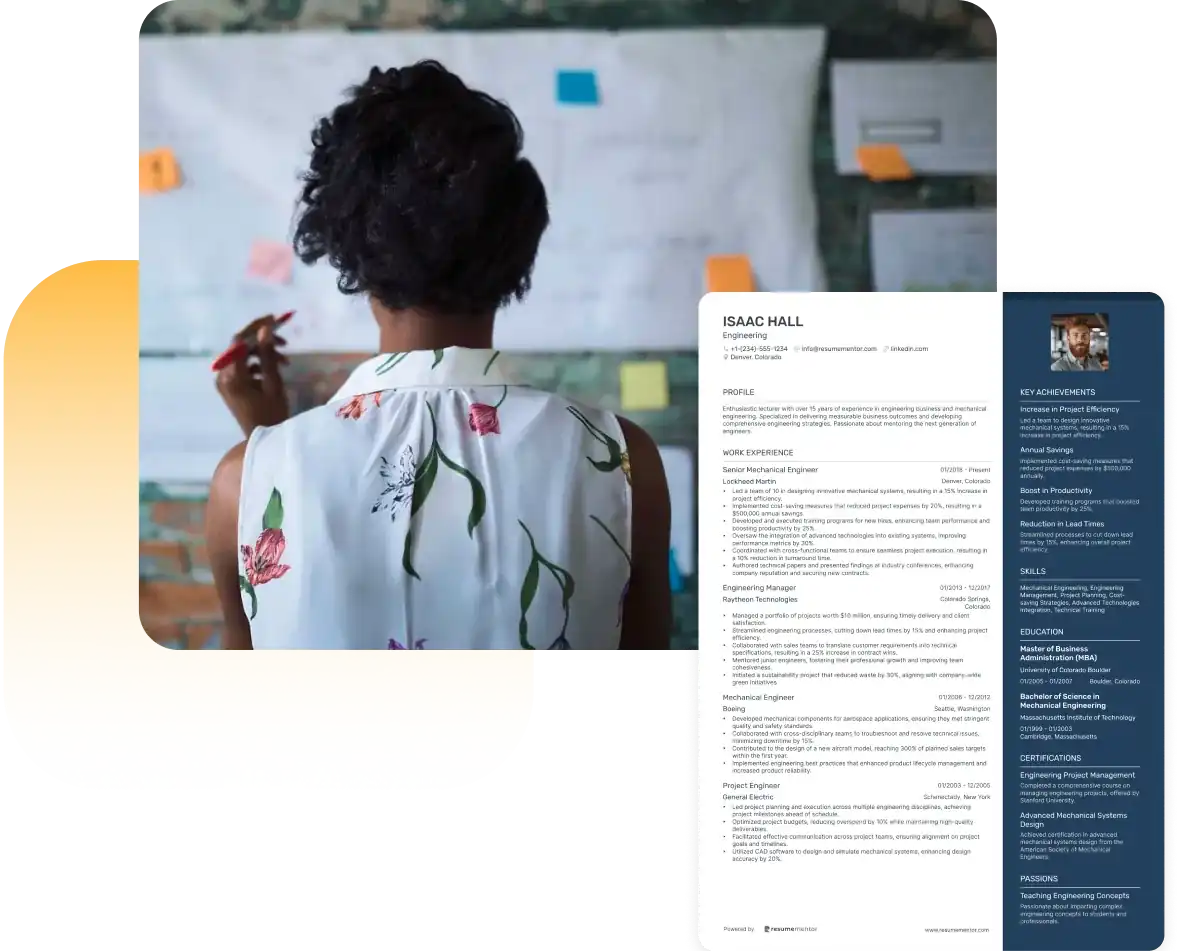
Continue Reading
Check more recommended readings to get the job of your dreams.
Resume
Resources
Tools
© 2025. All rights reserved.
Made with love by people who care.

